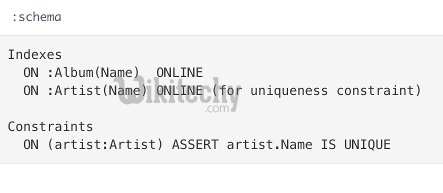Neo4j create constraint - neo4j tutorial - graph database
Relative Tags : neo , neo4j , graph database , neo4j cypher , neo4j python , neo4j tutorial , neo4j download , neograft
How to Create a Constraint using Cypher?
- A constraint allows you to place restrictions over the data that can be entered against a node or a relationship.
- Constraints help enforce data integrity, because they prevent users from entering the wrong kind of data.
- If a someone tries to enter the wrong kind of data when a constraint has been applied, they will receive an error message.

Neo4j constraints
Relative Tags : neo , neo4j , graph database , neo4j cypher , neo4j python , neo4j tutorial , neo4j download , neograft
Constraint Types
- In Neo4j, you can create uniqueness constraints and property existence constraints.
- Uniqueness Constraint
- Specifies that the property must contain a unique value (i.e. no two nodes with an Artist label can share a value for the Nameproperty.)
- Property Existence Constraint
- Ensures that a property exists for all nodes with a specific label or for all relationships with a specific type. Property existence constraints are only available in the Neo4j Enterprise Edition.
Create a Uniqueness Constraint
- To create a uniqueness constraint in Neo4j, use the CREATE CONSTRAINT ON statement.
CREATE CONSTRAINT ON (a:Artist) ASSERT a.Name IS UNIQUE
- In the above example, we create a uniqueness constraint on the Name property of all nodes with the Artist label.
- When the statement succeeds,the following message is displayed:

- Note:When you create a constraint, Neo4j will create an index. Cypher will use that index for lookups just like other indexes.Therefore, there's no need to create a separate index. In fact, if you try to create a constraint when there's already an index, you will get an error.
Relative Tags : neo , neo4j , graph database , neo4j cypher , neo4j python , neo4j tutorial , neo4j download , neograft
View the Constraint
- Constraints (and indexes) become part of the (optional) database schema.
- We can view the constraint we just created by using the :schema command.
:schema
- You will see the newly created constraint, as well as the index that was created with it. We can also see the index that was created previously:

Relative Tags : neo , neo4j , graph database , neo4j cypher , neo4j python , neo4j tutorial , neo4j download , neograft
Test the Constraint
- You can test that the constraint actually works by attempting to create the same artist twice.
- Run the following statement twice:
CREATE (a:Artist {Name: "Joe Satriani"})
RETURN a
- The first time you run it, the node will be created.
- The second time you run it, you should receive the following error message:

Property Existence Constraints
- Property existence constraints can be used to ensure all nodes with a certain label have a certain property.
- For example, you could specify that all nodes labelled with Artist must contain a Name property.
- To create a property existence constraint, use the ASSERT exists(variable.propertyName) syntax.
CREATE CONSTRAINT ON (a.Artist) ASSERT exists(a.Name)
